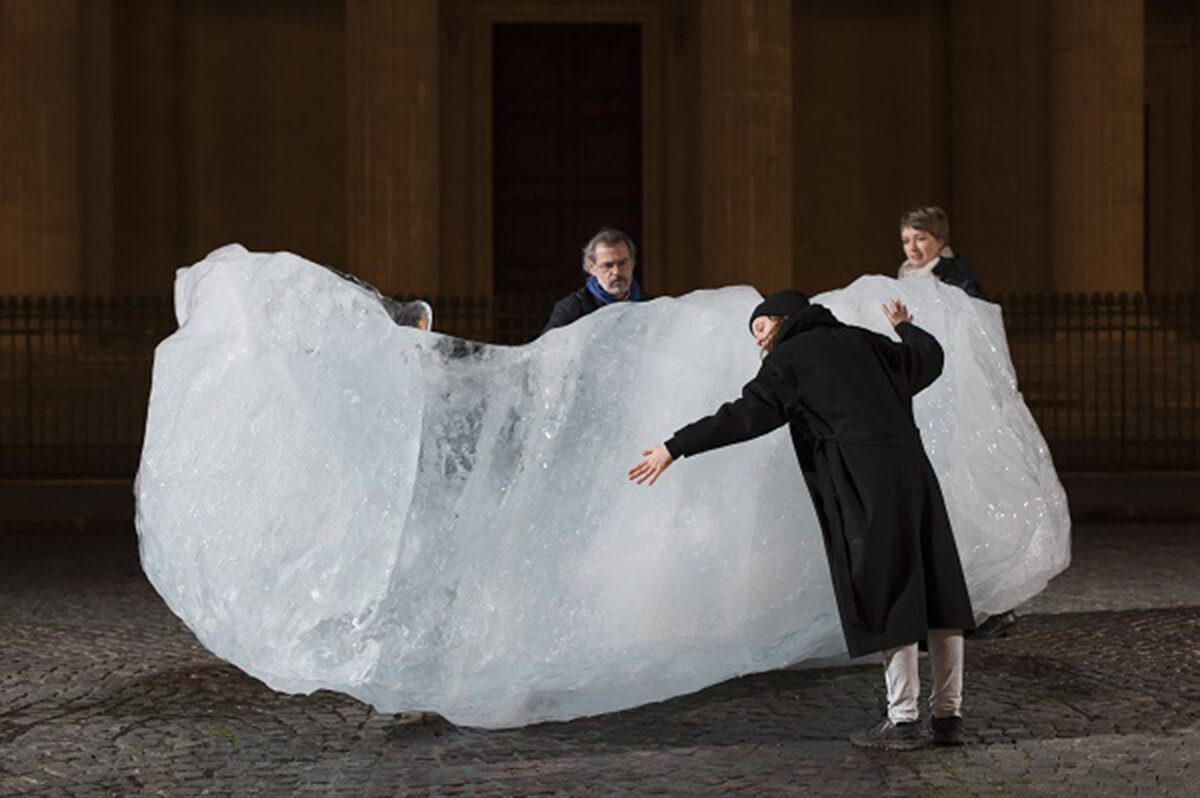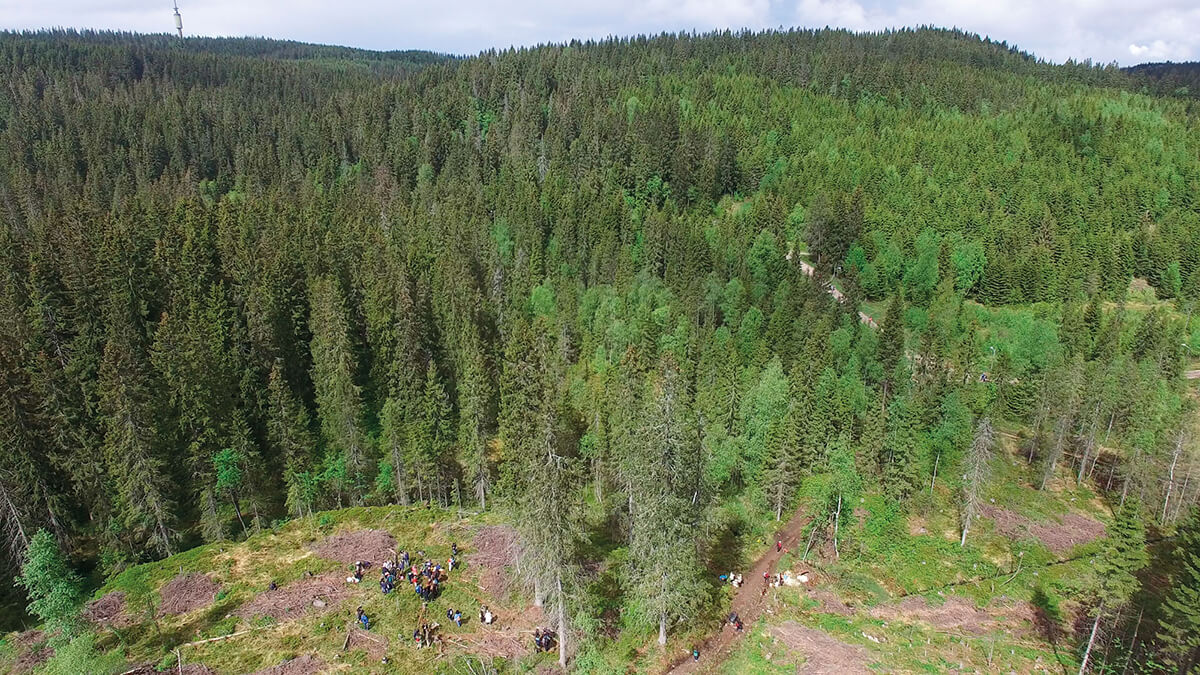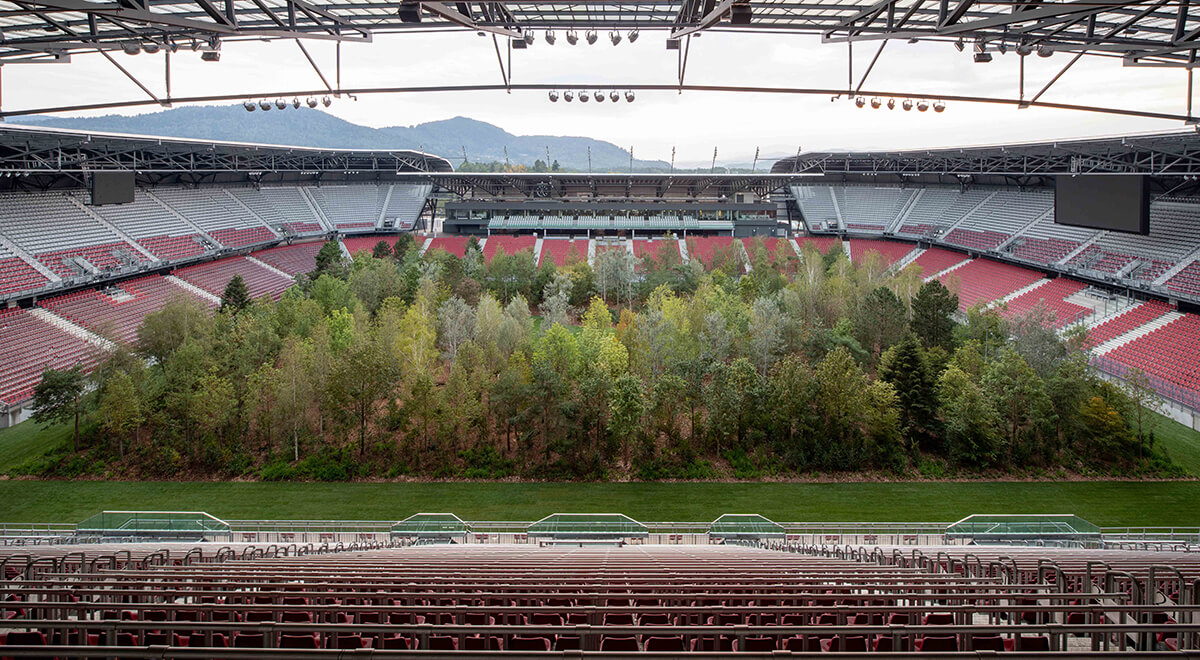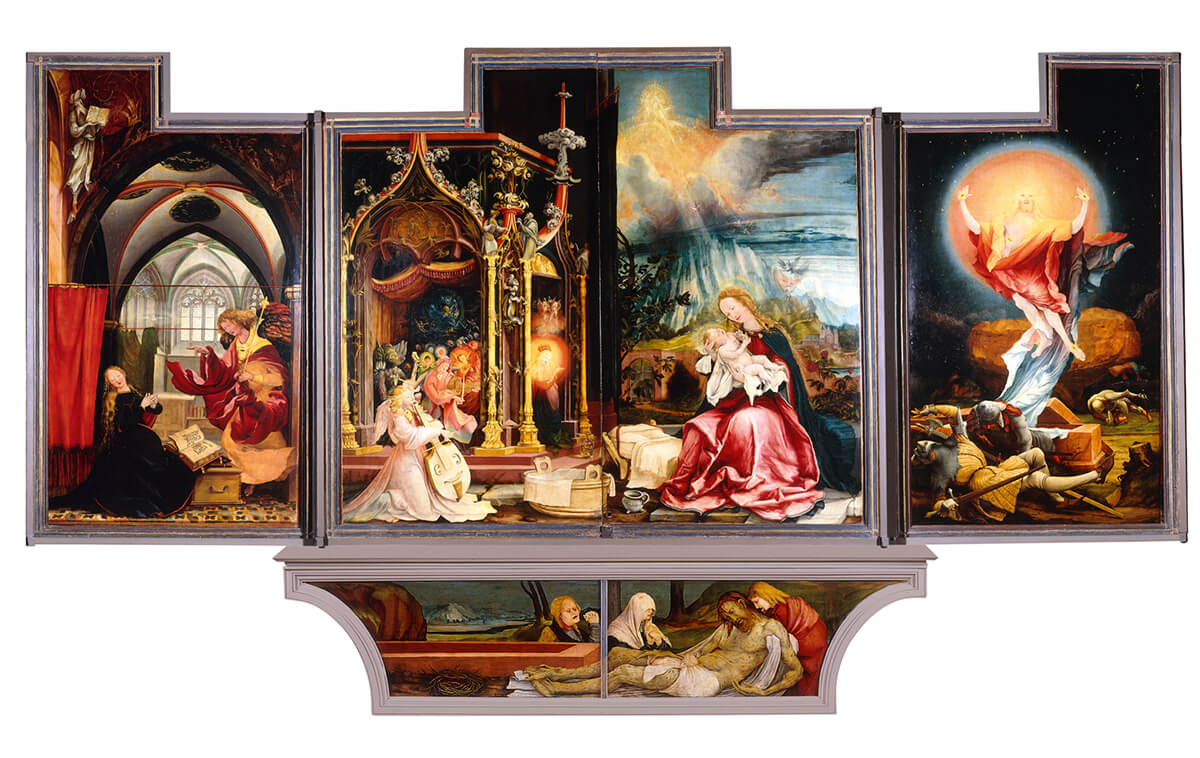Big Ice Art
Dean Kissick
December 3, 2019

Don’t read this essay. Print it. Seal it. Bury it in the cold ground for a hundred years. Leave it for somebody else to read a hundred years from now.
[A century passes.]
Oh, century! And so, future reader, let’s begin. Come with me on a journey back to the 2010s, when we all began to really lose our minds. At the beginning of the decade, Karl Lagerfeld brought an iceberg (well, a 265-ton block of ice and snow to be shaped into an iceberg by his team of ice sculptors) from northern Sweden to the Grand Palais, in Paris, for the centerpiece of his Fall 2010 Chanel show.
Five years later, Olafur Eliasson brought a dozen massive blocks of ice calved from a fjord in Greenland to Paris again, to the Place du Panthéon, and arranged them on the cobblestoned ground in the shape of a clock. The piece, in collaboration with geologist Minik Rosing, was called “Ice Watch.” His purpose however, was very different from Lagerfeld’s. Eliasson was going to raise awareness of climate change.
He would do so by bringing some ice to melt in the French capital. He’d timed his installation to coincide with the city’s all-important UN Climate Conference COP21, where world leaders were meeting to set longterm goals for reducing greenhouse gas emissions and global temperature rises. So while politicians out in suburban Le Bourget agreed on a series of vague and unenforceable targets that won’t be met, across town in the Latin Quarter the arctic ice slowly melted. Had they gone there, the politicians might have been moved to try harder. But also they may have wondered, what does any of this really have to do with climate change? This sea ice wasn’t melting because of global warming, but rather because it had been shipped around the world to the Place du Panthéon.
One night Eliasson invited a group of dancers and choreographers to improvise an interpretative dance around his frozen clockface. They spun slowly around the ice’s surface, hugging it, stroking it, putting their ears to it and listening to the sound of it melting, and also to the music by Jamie XX. Doesn’t this sound like a nightmare? An aesthetic nightmare? What could Paris, once home to Picasso, Debussy and the Ballets Russes, have done to deserve this?
“Olafur,” one of the dancers told the New Yorker, “wanted us to become part of a gradual journey towards empathy … For me, the point was not to become a crystallization of the ice but to be part of the transition of the ice.” To understand the ice, in other words, Eliasson and his dancers suggest that we have to first become the ice. Only then can we understand the impact of climate change. If transporting an iceberg more than a thousand miles was a decadent spectacle of glamor and obscenity for Lagerfeld, in Eliasson’s hands the same gesture is reimagined as an empathy generator. Icebergs are just more free-floating signifiers in the great cultural morass. One man’s sexy autumnal mise-en-scène is another’s millenarian dread clock.
For her conceptual art piece “Vatnajökull (the sound of),” (2007–08), Katie Paterson connected a microphone she placed in the Icelandic Jökulsárlón lagoon to a phone line. Anybody who called could listen to the glacier above melting in real time. Like Eliasson’s dancers becoming the ice, the inspiration for her work came, she told NPR, from a series of bedbound psychedelic fever dreams during which she began to imagine that the glass of water she was drinking was turning her into a part of the disappearing glacier. This reminds me of when I took lots of MDMA for the first time and thought I was a dog.

A more recent work, “Future Library,” (2014-2114), began with her planting a thousand Norwegian spruce trees in the forest outside of Oslo and commissioning the first of a hundred original books from a hundred authors, starting with Margaret Atwood. Every year, a ceremony is held to mark the receipt of each new title. The first will be available to read in 2114, when librarians will cut down all of the spruces, turn them into paper and print all of these books for the first time. Until that day, Paterson’s growing collection of manuscripts will remain in storage. When Oslo’s new Deichman Library opens next year, they’ll be enclosed under glass in a “Silent Room.” A silent room, in a library. A room full of books that nobody’s allowed to read. Fantastic.
Every writer invited to contribute to the project is given a box for their manuscript and three rules: they can’t say what’s inside, they can’t just contribute a photo album, and they have to include at least a word of text. It’s a powerful image: in the smoldering ruins of 22nd-century Norway, in a black sea of ashes, the last men uncover a hidden stash of a hundred books by the likes of Atwood, Han Kang, Karl Ove Knausgård, David Mitchell, Elif Shafak and Sjón and finally, carefully open them to find they’re all just a single word.
Have we really given up on the novelistic form so much that our best writers have to give their books to artists to entomb under glass for a century? But art, with all its money, consumes everything now: literature, dance, environmentalism, good intentions, the Norwegian library system.
*
One of many nightmare scenarios for the future is that culture in the 2110s might not look so different from culture today. Three years after the opening of the Future Library, in the year of our lord 2117, Pharrell’s last song “100 Years” will be released. So far, the only people to have heard this song are Pharrell, his producers, and the hundred special guests that were invited to a special listening party thrown by Rémy Martin Louis XIII cognac in Shanghai. What if this is the greatest song ever written, and none of us will ever get to hear it?
Afterwards, Pharrell’s last song was locked in a Fichet-Bauche safe in Rémy Martin’s cellars for a century to raise awareness of climate change and Louis XIII cognac. The song was recorded on a single disc made of clay. The safe was designed to allow water in. So, if the sea rises high enough to flood the city of Cognac, Pharrell’s song will dissolve and be lost forever, along with much of world civilization. “I think it’s important,” he told Vogue, “that every human being—from the most eco-aware person to someone that’s driving a diesel truck—always has a sense of terrestrial awareness.”
Pharrell doesn’t drive a diesel truck himself. He drives a Ferrari Enzo, Rolls-Royce Phantom, Mercedes-Benz McLaren SLR, and Hybrid GMC Yukon SUV. But perhaps this is what American soft power amounts to these days: pretending to care about the future for French cognac manufacturers tapping influencers and the Shanghai luxury market.
None of these are complicated projects. Pharrell’s “100 Years” won’t be released for 100 years. Paterson’s “Future Library” is a library for the future. Visitors to Eliasson’s “Ice Watch” can watch the ice melt. Also, it looks like a watch. As society turns against nuance, expect plenty more massively expensive and unsubtle environmental artworks to follow. Just last September, curator Klaus Littmann, taking inspiration from a Max Peintner drawing from 1970, moved a forest of 300 trees into the Wörthersee soccer stadium in Klagenfurt, Austria to make a piece called “For Forest.” This is the new kind of land art, where you just move things into cities. All 300 trees will remain there until the end of October, when they’ll be replanted nearby as a “forest sculpture.”

All of these ideas take a lot of carbon to stage. For the London sequel of “Ice Watch,” Eliasson commissioned a report on the carbon footprint of shipping nine refrigerated containers of ice from Nuuk, the capital of Greenland, which was found to be 55 tons of CO2 total; roughly equivalent, the report says, to 52 people flying from London to Greenland and back to see the ice themselves. Paterson’s library project takes the opposite approach, with flights for herself and one of her authors to Norway every year to perform a handover ceremony, and likely causes more emissions.
However, rather than getting bogged down in the logistics of jetting around and around the world to exhibit or experience contemporary art, and how this is accelerating climate change—because, ultimately, the carbon footprint of the art world remains relatively insignificant compared to other industries—we might want to ask more questions about how power works, who really makes environmental policy decisions, and where, if anywhere, the culture industry fits into this puzzle. Who’s funding these projects, for instance? Where does the money come from?
All three iterations of Eliasson’s “Ice Watch,” in Copenhagen, Paris and London, as well as his less didactic, more joyful past folly the “New York City Waterfalls,” (2008), were underwritten by businessman and Democratic Presidential candidate Michael Bloomberg’s charitable-giving foundation Bloomberg Philanthropies. Bloomberg is around the ninth-richest man in America. He likely has a significant portion of his $60-billion fortune invested in oil and gas companies. He’s an advocate of drilling and fracking and author of a book, Climate of Hope: How Cities, Businesses, and Citizens Can Save the Planet (2017), in which he explains why he thinks fracking makes sense, why he doesn’t want to stop the Keystone XL oil pipeline, and describes natural gas as “a godsend for the environment and public health.”
He’s also a UN Special Envoy for Climate Action. The most recent “Ice Watch,” in London over Christmas 2018, had two locations: outside Tate Modern, which had recently ended its 26-year sponsorship deal with oil giants BP following years of protests, and outside Bloomberg’s European corporate headquarters. This is centrist art for centrist politicians. A melting block of ice from halfway around the world signifying nothing; neoliberalism given sculptural form in the public square.
As for the “Future Library,” it’s supported by the City of Oslo; in other words, by a booming oil economy. It’s just another way of spending some of that oil money in a country in which fossil fuel production accounts for around 20 percent of the economy.
The library and the frozen clock are bad art projects, certainly. But they’re also bad activist projects, because they contribute to climate change while doing nothing to alleviate it, nor offering any solutions, and are funded with the spoils of fossil fuel extraction. And they also do something far worse.
*
Let’s jump backwards in time again, to Alsace country in the early 16th century. In the small town of Isenheim, the German artists Nikolaus of Haguenau and Matthias Grünewald are painting an altarpiece for the Monastery of St. Anthony. Their resulting Isenheim Altarpiece is a rather unusual masterpiece. Its late-gothic painted panels and woodcarvings were designed to alleviate the physical symptoms and hallucinatory psychosis caused by consuming rye bread contaminated by ergot fungus. Those suffering from ergot poisoning would come to the monastery and pray in front of the altarpiece in the hope of being cured, which led art critic David Levi Strauss to describe it as a work of “therapeutic realism.” The altarpiece promised to ease their suffering through a magical combination of ritual and art.

Today’s most prominent ecological artists practice a new form of therapeutic realism that promises even more: to heal the world through vague metaphorical propositions and performances. There’s something very ritualistic, medieval even, about the image of Eliasson’s dancers caressing the ice and listening to it die; or Paterson’s mournful, funereal library accession ceremony earlier this year, in which novelist Han Kang trekked through the Norwegian woods dragging a white sheet behind her, wrapped it around her manuscript like a shroud, then handed both over to be locked away for the rest of her life.
These are magical rituals. The idea seems to be that we can save the world if people, some other people, not the artists or their patrons, stop using all the fossil fuels and destroying the Earth, and that it’s the artist’s job to raise awareness of this by building heavy-handed metaphors out of forests and ice sheets and the landscape itself, and organizing performances like these in which everybody just feels really bad about things. It’s not only ineffective, it’s irresponsible, because it co-opts and detracts from more meaningful efforts at conservation and activism, propagating the comforting delusion that everything will be okay if we just care more—that we can save the world by cultivating the right feeling. But we can’t.
In the words of writer and researcher Lucy Chinen: “About big ice art: believing that lots of people will do something based sheerly on encountering the materiality of global warming in the form of shipping a giant Olafur Eliasson melting ice turd gesture is the biggest failure of humans.”
These grand artistic gestures may be supposed to rouse us from our apathy, but I think that they actually make us feel more passive and more detached, by dangling these wishful, escapist fantasies in front of us. They show us how far removed the liberal conscience has grown from reality.
Big ice art won’t save the world, and neither will essays like this. So what can be done? In The Great Derangement: Climate Change and The Unthinkable (2016), Amitav Ghosh writes that “the great, irreplaceable potentiality of fiction is that it makes possible the imagining of possibilities.” The question is what kinds of new lives and worlds writers and artists might imagine today? Eliasson, for me, is at his best when he’s indulging his love of artificiality. Raising a gigantic fake sun in the Tate, chasing waterfalls around Manhattan, or dyeing rivers green in cities around the world.
Perhaps he should take his dreams of geoengineering further? If there’s an artist to take land art to the next level by seeding the oceans with iron and rich phytoplankton blooms, or the clouds with sulfur dioxide that turns the skies bright crimson, or the Arctic with reflective sands to raise the Earth’s albedo, or by inventing a new kind of carbon sequestration machine in a large Berlin factory-studio and injecting that sequestered CO2 into vast underground basalt formations far below Iceland—to really start playing god—then surely it’s him.
As for what a novelist might do; rather than locking their writing up in a Norwegian vault, they might try and write a book that would inspire readers to act in the present. Edward Abbey’s 1975 novel The Monkey Wrench Gang inspired a whole generation of militant ecological activists. Its imaginative but practical depictions of acts of vandalism and sabotage influenced direct-action groups like Earth First! and the Earth Liberation Front, which takes a monkey wrench as its logo. How about a great American novel that dramatizes the cozy relationships between our leaders and oil companies, or shows you exactly how to turn off a pipeline, or shoot a Large Power Transformer with a rifle, or blow up the explosives silos guarded by mercenary armies on the fracking plains, or disable an oil refinery with a malicious computer worm? Hypothetically, of course. As for Pharrell, he could burn all his sports cars in a ceremonial bonfire.
The road to hell is paved with good intentions. The climate may well completely collapse before feel-good liberalism. But if the artists and writers engaging with the environment are to do anything, they might at least come up with more imaginative and radical ideas.